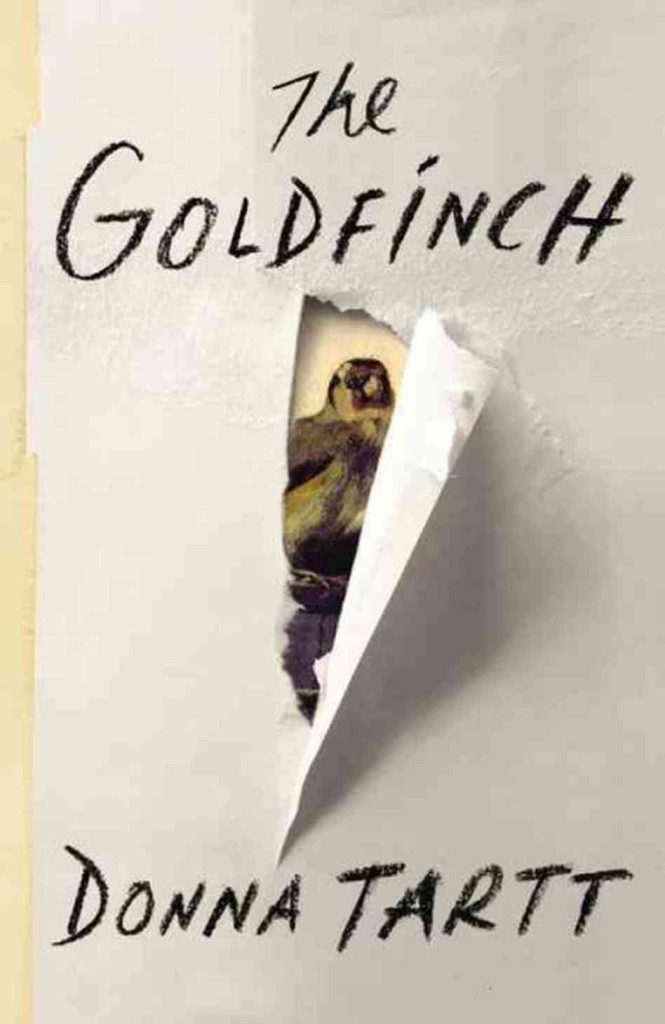Book review Monday: The Goldfinch, by Donna Tartt
Programming note: book reviews are back on Mondays (for now), as my Tuesdays will henceforth be consumed by blogging about The Bachelor over at Previously.TV (you can check out my posts here).
I’m a big fan of Donna Tartt — really, as big a fan as one can be of an author who has only produced three novels. I thought both of her first two books were brilliant: both The Secret History and The Little Friend were well-crafted, chilling, and un-put-downable. So, I was really excited to read Tartt’s latest effort, The Goldfinch. Since I’m an enthusiastic fan of her work, I dove into The Goldfinch without even bothering to read its flap-copy, let alone a review. Unlike how I approached Meg Wolitzer’s The Interestings, I went into this thing completely blind, and I’m glad I did. The Goldfinch is one of those books with a twisty, turn-y plot that’s more enjoyable if you have no sense of what to expect; it’s like a haunted house ride, and you’re constantly waiting for the next ghost to pop out of nowhere and give you a thrill.
The barebones plot summary of the book is as follows: thirteen year-old Theo Decker and his mother are wandering through a museum in New York City when a terrorist’s bomb is detonated. Theo survives, and — for reasons that are a bit complicated to go into here — walks away from the scene with an exceedingly rare painting, Carel Fabritius’s The Goldfinch, in his possession. The novel then follows Theo from his early teenage years into adulthood, tracing his wild, unstable trajectory as he’s bounced from house to house, state to state, country to country, and his increasingly precarious situation as an international art thief. Even though the novel is a hefty 755 pages long, the plot moves — and changes — so quickly, that you understand why Tartt expended so much ink capturing the many facets of Theo’s story.
As always, Tartt’s writing is impeccable. The characters, like real people, are colorful, yet sympathetic, understandable, and yet essentially mysterious. Theo, as the narrator, is complex and multi-dimensional. At various times, I felt sorry for him, was annoyed by him, rooted for him, and wanted him to fail. Tartt masterfully develops the jarring conflict between Theo’s inner life — one wracked by guilt and self doubt — and his seemingly confident and respectable outer life. Other characters are also given their own layers; although there are a few stock characters thrown in (Kitsey and Andy spring to mind), most of the main characters seem like real people, with their good sides and bad sides, noble impulses and cowardices.
One of the characters who plays a major role in the story is Hobie, the proprietor of an antiques shop whose life and livelihood eventually become intertwined with Theo’s. Although Hobie was one of the few characters — perhaps the only character — in the story who seemed to have no human failings apart from a few mild eccentricities, I enjoyed Tartt’s descriptions of him nonetheless. I particularly loved this passage:
By contrast Hobie lived and wafted like some great sea mammal in his own mild atmosphere, the dark brown of tea stains and tobacco, where every clock in the house said something different and time didn’t actually correspond to the standard measure but instead meandered along at its own sedate tick-tock, obeying the pace of his antique-crowded backwater, far from the factory-built, epoxy-glued version of the world. Though he enjoyed going out to the movies, there was no television; he read old novels with marbled end papers; he didn’t own a cell phone; his computer, a prehistoric IBM, was the size of a suitcase and useless.
Now, a small complaint. As gifted as Tartt is as creating marvelous, complex, interesting characters, her ear for dialogue seems, to me, to be fundamentally off. The characters in this book are so real, and yet they don’t talk like real people — or, at least, not like real people in this century. For example, Kitsey, a love interest, is supposed to be a young, modern woman in her mid-twenties living in present-day Manhattan, and interested in fashion and parties and glamour. Yet she sounds as if she was plucked from a Connecticut estate in the 1940s. She says things like, “Really? Are you sure it’s all right? We none of us drink it — Daddy always ordered this kind…” and, “Do say, Theo, I know you must prefer one of the two.” Similarly, Theo, as a teenager in the mid-2000s, said, in one passage, “Say, you ought to try one of these peppermints.” Say? What kind of old-timey teenagers has Donna Tartt been hanging around with, if this is her impression of how young people talk? I often found the dialogue to be so jarring that it took me right out of the story, and made me wonder whether Tartt wrote this novel from inside of a time machine.
My only other complaint about this book was the finish. Without giving too much away, things get pretty neatly tied up by the end in a way that felt out-of-step with the rest of the story, which was consistently wild and unpredictable and chaotic. Also, at the very end of the book, Theo, the narrator, spends a long time pondering the meaning of life, death, and art in a way that I didn’t find particularly engaging. I understand that Tartt was trying to imbue the story with greater meaning, but I don’t think a soliloquy was necessary. On the contrary, I think Theo’s relationship throughout the book with The Goldfinch in particular and with art in general spoke for itself, and didn’t need to be elaborated quite so explicitly at the end of the novel.
Despite my little complaints about the book, overall, it was a great read, and Tartt’s writing is astonishing. As a writer, I appreciate her exceptional ability to cast otherwise mundane objects, moments, and feelings in a meaningful light. I recommend this book for other Tartt fans, for those looking for a long but engaging read, and for those interested in fiction involving art.


Leave a Reply